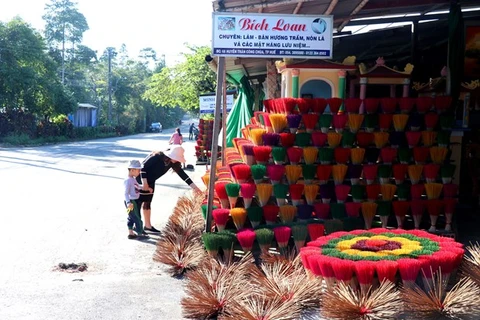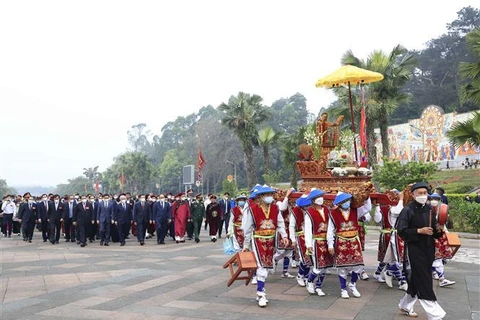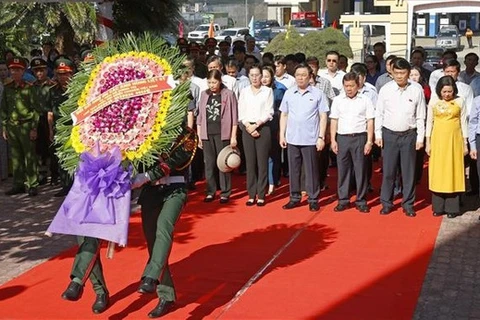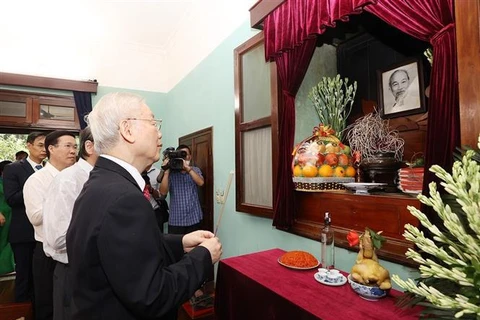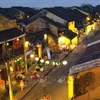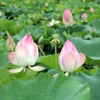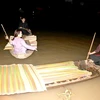Hanoi (VNA) – In Vietnamese culture, burning incense sticks is considered a bridge between the present life and the spiritual world. Incense-making villages have joined hands to preserve the traditional ritual.
Quang Phu Cau Village (Hanoi)
Quang Phu Cau village in Ung Hoa district of Hanoi is one of the most well-known incense-making villages in Vietnam. Many families in the village have kept the incense-making craft for more than a century. They consider it a job of pride.
In the past, making incense was just a part-time job that farmers usually did when they were not busy with farming. However, now, it is the craft that brings income to many people.
When the Lunar New Year (Tet) festival comes, incense makers in Quang Phu Cau village work at full capacity to meet demand across the country.
Cao Thon musk incense village (Hung Yen)
Located on the left bank of the Red River, Cao Thon village in Bao Khe commune of Hung Yen province is considered the cradle of incense making with a history of over 200 years.
 The incense powder of Cao Thon village is a combination of many traditional medicine herbs including angelica, cypress, agarwood, cinnamon, and licorice. (Photo: VNA)
The incense powder of Cao Thon village is a combination of many traditional medicine herbs including angelica, cypress, agarwood, cinnamon, and licorice. (Photo: VNA) The number of households that make incense manually in the village is now counted on the fingers of one hand as almost all local incense makers use machines to increase productivity and reduce workforce. However, the quality of the incense remains unchanged and the production still follows the process and know-how passed from older generations.
The incense powder of Cao Thon village is a combination of many traditional medicine herbs including angelica, cypress, agarwood, cinnamon, and licorice.
Hoang Xa musk incense village (Hai Duong)
Hoang Xa village in Nam Chinh commune, Nam Sach district, Hai Duong province, has long been famous for making incense – a hereditary craft.
The main character that creates the brand for Hoang Xa musk is a blend of traditional herbs such as cloves, rhubarb, anise, ginseng, and agarwood. When lit up, Hoang Xa incense emits a light aroma of herbs.
More notably, when other incense villages use drying oven technology, Hoang Xa still follows the traditional method taking advantage of solar heat to dry incenses which will have a natural fragrance.
Phia Thap village (Cao Bang)
Phia Thap is an ancient village located in the limestone mountains of Phuc Sen commune in Quang Hoa district of the northern mountainous province of Cao Bang.
It is one of the five craft villages in the province that have been recognised as their crafts have a history of over 100 years.
Phia Thap incense village is famous for Nung An ethnic group’s traditional fragrant incense making. The incense is made manually from materials taken from the forest such as apricot trees, and the leaves of the gourd trees.
Phia Thap incense is welcomed by consumers and tourists because they do not contain harmful chemicals.
Quy Chau village (Nghe An)
Incense-making craft has existed in Quy Chau village for nearly 40 years. Up to now, there are about 200 households in the village doing this craft.
To create the scent typical of the western mountains of Nghe An, local people follow a careful process.
The main ingredient is aloe wood, the resinous wood from the Aquilaria tree which is abundant in the mountain region of Nghe An province. It has a light fragrance. After being collected, the wood is cleaned, dried, and ground into a fine powder to make incense.
Other materials include star aniseed, cardamom, cinnamon, bagasse, and some special herbs which are the secret of each maker. The incense sticks are made from neohouzeaua trees. Making incense sticks requires experience so that they will curve after being burned.
Once burned, Quy Chau incense produces lightly fragrant, thin smoke and beautiful curve.
Bao An village (Ha Tinh)
Among incense-making villages in Vietnam, Bao An village in Thach My commune, Loc Ha district, Ha Tinh province, is not a name with long history but its products have good quality like those of other well-known villages.
Like many other traditional craft villages, in Thach My, every villager can participate in the process of making incense, from children to the elderly, from skilled workers to seasonal ones.
Thuy Xuan incense village (Thua Thien-Hue)
Thuy Xuan village, which is located about 7km away to the southwest of Hue city, is famous for making incense for hundreds of years.
When arriving in the village, the first eye-catching image for many people is the blooming bouquets of incense sticks with many vibrant colors and the aroma of incense in the air.
Thuy Xuan villagers have made their traditional craft village into a unique tourist attraction. In the village, Huyen Tran Cong Chua street is coloured by incense bouquets. The bouquets are arranged neatly, becoming one of the attractive places for tourists to visit and take photos.
Thuy Xuan villagers produce different kinds of incense such as cinnamon incense, lemongrass incense, odor eliminator, ring incense, and incense buds.
Quan Huong village (Quang Nam)
Located along National Highway 1A, Quan Huong village has made incense for hundreds of years.
The villagers carefully select materials to make incense. For example, they choose cinnamon grown in Tra My district, or incense sticks made from La Nga bamboo. The sticks must be dried so that the incense sticks will burn undisputedly.
To incense makers in Quan Huong village, the craft not only brings them income but traditional spiritual values. Therefore, they are very careful in each stage from preparing raw materials, and making incense to packaging finished products./.




